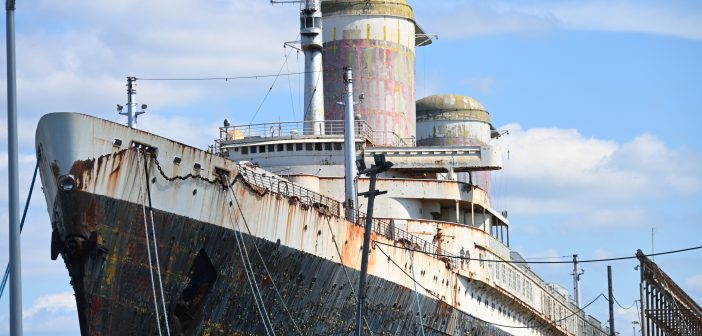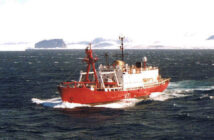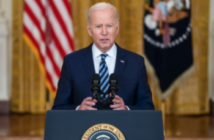Since the dawn of the 20th century, ocean liners have been physical manifestations of great powers’ industrial and artistic prowess.
For decades, Britain, France, Germany and Italy dueled on the North Atlantic for the prestige associated with building the fastest or most luxurious ocean liner.
At a time before air travel, extra speed meant a shorter voyage across the Atlantic.
The United States, sadly, was a laggard in the transatlantic contest, with dour and pokey ships until Washington was awarded one thoroughbred German liner — the Vaterland. Seized at the start of World War I and renamed Leviathan, she was retained after the conflict as a reparation.
It wasn’t until after World War II that America built a liner that surpassed them all in raw performance — the SS United States, the flagship of the United States Line and so, the nation. It’s first crossing of just over three days was enough to wrest the Blue Ribband — awarded to the fastest Atlantic liner — from RMS Queen Mary that held the honor for two decades.
The United States was a breakthrough example of the public-private partnership that Navy Secretary Carlos Del Toro rightly argues must be resuscitated. Indeed, as my friend Chris Cavas, the co-host of our Cavas Ships podcast notes, it was the ultimate example of a government-industry partnership, with private companies for decades after using standardized government merchant ship designs.
The new ship, nearly 1,000 feet long would be a technological showcase not just for commercial reasons. She was also designed as a fast troop transport during war, leading to a modernist interior devoid of wood and replete with fire proof materials and technologies.
Ocean liners had always proven their worth as troop ships, none more so than the two massive Cunard liners Queen Mary and Queen Elizabeth that during World War II together transported hundreds of thousands of allied troops around the world at such speed, no submarine could intercept them.
On one voyage alone, the Queen Mary carried more than 16,000 soldiers across the Atlantic, a record that stands to this day.
The United States, designed by the nation’s greatest naval architect, William Francis Gibbs, and built by Newport News Shipbuilding set a high watermark for hydrodynamic efficiency, new materials and a cutting-edge powerplant that pioneered technologies that would find their way into the first generation of giant new supercarriers of the Forrestal-class.
Pack a staggering 240,000 horsepower into a light and sleek 53,000-ton hull and you can achieve record sustained speeds of nearly 40 knots that allow an Atlantic crossing with 2,000 passengers and 1,000 crew in a little more than three days, a record that still stands.
But the advent of the jet age spelled the demise of ocean liners as regular transportation. The United States was decommissioned and laid up in 1969. The Queen Mary was retired two years earlier, but became a popular hotel in Long Beach.
Now, the United States is slated to be sunk Florida as a destination for divers.
The notion of sinking a ship named for the nation is never a good omen in an era of great power competition.
The right approach is put the brakes on this short-sighted and unimaginative outcome and strike the same kind of public-private partnership that birthed her — to return her to passenger service.
Doing so would be giant undertaking given the sorry state the ship is in after decades of neglect. But it would also mark a national undertaking to build the very skills needed for both military and commercial shipbuilding, helping train a new generation of ship fitters, welders, electricians and myriad other skilled trades that are vital for military and commercial shipbuilding that are now in short supply.
The goal shouldn’t be to revive a single historic ship, but lay the foundations of a more globally competitive US shipbuilding industry that would benefit naval and commercial capabilities. The current US approach of underwriting naval construction while ignoring commercial manufacture except that specific by the Jones Act is absurd and short sighted.
America’s maritime and nautical industry can all play a role as can allied nations with the requisite technology and expertise. For example, the Italian parent of the company that’s building the Navy’s next generation frigate, Fincantieri Marinette Marine, is one of the world’s leading builders of cruise ships.
The replacement of her labor- and energy-intensive steam plant with a new diesel-electric drive would make her far more economical to operate, perhaps allowing her to showcase efficient, clean propulsion as a model for others to follow.
After RMS Queen Elizabeth 2 traded in her steam propulsion for diesel-electric drive, she not only dramatically cut her fuel consumption, but also increased her top speed and reliability.
And bringing back United States could also prove a financial windfall.
Since the 1960s, only two ocean liners have plied the North Atlantic — the QE2 and its successor, the Queen Mary 2. In an era when cruise ships look more like upended milk cartons and Clorox bottles, these two thoroughbreds turned heads in every harbor they visited.
They also enjoyed brisk business because there has only been one true ocean liner at a time plying the Atlantic.
The United States can again become a storied flagship of a maritime nation, and not just a physical manifestation of a noble past, but a brighter future.
The very last thing that should happen is for the United States to go to Florida to die.




